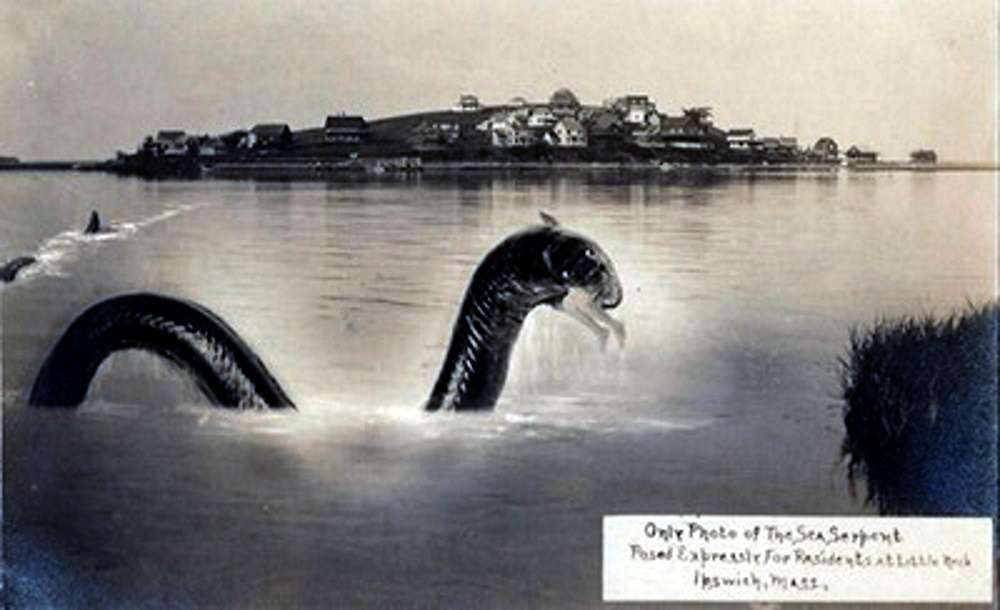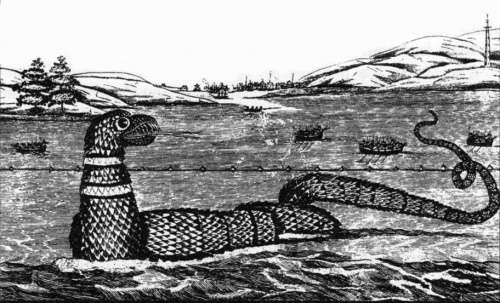When a New England sea serpent was beached off the coast of Scituate, Mass., in 1970, it marked the continuation of a New England tradition going back to 1638. Ever since then, sea serpents frequently visited the New England seashore.
It started in 1641, when credulous English traveler John Josselyn wrote An Account of Two Voyages to New England. In it, he described a sea serpent seen three years earlier by passersby off the coast of Gloucester, Mass.:
They told me of a sea serpent or snake, that lay coiled up like a cable upon a rock at Cape Ann; a boat passing by with two English on board, and two Indians, they would have shot the serpent, but the Indians dissuaded them, saying that if he were not killed outright, they would be in danger of their lives.
Drawing of the Gloucester sea serpent of 1817.
The most spectacular sea serpent sightings in 1817 fooled the eminent natural scientists of the day. It took a fisherman to figure out what everyone was all excited about. The scientists, of course, didn’t believe him.
Sea Serpents
Just a few years after Josselyn recorded the sea monster sighting in Gloucester, someone spotted another creature off the coast of Lynn, Mass. The sightings would continue for decades.
Some sea serpents were hoaxes, some may have been giant anacondas and some may have been the product of an overwrought Puritan imagination. The Puritans seemed all too eager to believe in strange creatures and unearthly phenomena prowling through the howling wilderness.
Snake With Tumors
Not until the 19th century did sea monster sightings happen seasonally. Throughout the summer of 1817, hundreds of people — including the crews of four whaling vessels — sighted a sea serpent in Gloucester Harbor.
W. Jeffrey Bolster, in The Mortal Sea, described the excitement that followed. The Linnaean Society of New England traveled to Gloucester to collect evidence, distributing questionnaires to witnesses. One witness said the serpent’s head looked like the head of a turtle, but larger than a dog. Another likened it to the head of a rattlesnake but as large as a horse’s head.
The Linnaeans found a small serpent with bumpy skin, which they identified as the sea serpent’s baby. After dissecting the serpent, the Linnaeans published a pamphlet announcing the discovery of an entirely new genus, the Scoliophis Atlanticus.
It turned out to be a “Colubar constrictor with tumors” — a cancerous black snake. That didn’t deter the Linnaean Society, an elitist group of gentlemen. The society issued a report on Scoliophis Atlanticus, printed in London. Harvard professor William Dandridge Peck submitted a paper to the American Academy of Arts and Scientists about “an enormous animal of the serpentine order.”
Even William Bentley, Salem’s beloved Unitarian minister and diarist, believed in it. “His repeated appearance last week is not doubted,” he wrote.
Captain Rich Catches the Monster
A Gloucester sea captain named Rich decided to find out the truth. He knew that sea serpents showed up when barometric pressure was high and the sea glassy. He hired a crew of respectable men who had seen the serpent. They sailed to a spot where they’d seen the serpent.
The Boston Weekly Messenger described what happened next. Harpoons at the ready, the crew waited in a whaleboat. The
crew all agreed to a man, that what we then saw was the supposed Serpent, which had been seen at that place and at Gloucester Harbur.
Captain Rich said he’d swear under oath that he’d seen a hundred-foot serpent.
They decided to harpoon it, but they first had to chase the monster for five days. Finally, when they harpooned it, wrapped it in a sail and brought it aboard, they discovered its true identity: a bluefin tuna.
How had people mistaken it for a 100-foot sea monster? “The supposed Serpent is no other than the wake of a fish such as we have taken.” He explained that on a calm day, the speedy tuna heaved up “little waves the true color of the ocean.” Those waves appeared at a distance like the humps of a serpent’s back.
But people still believed in sea serpents.
More Serpents
Two years later, people reported a serpent off the coast of Nahant, Mass..
On Aug. 2, 1868,people saw a sea monster floundering in a salt marsh on the west side of Eastport, Maine. It looked like a shark, but it seemed part beast and part fish. Spectators rushed to the edge of the marsh to stare at the creature, then shoot at it. It received 70 musket balls, but didn’t die until the next day. Harper’s Weekly ran an illustration of the “wonderful fish” in its Oct. 24, 1868 issue.

Harper’s Weekly illustration of the “wonderful fish” — probably a basking shark.
The creature was then taken to Bangor, Maine, and put on display, according to the Bangor Daily News. It was over 30 feet long and weighed 11 tons with one enormous dorsal fin, two side belly fins, a sharklike tail and two huge legs ending in web feet. Its teeth resembled “sharp-pointed popcorn.” After a while the carcass began to stink, and someone hauled it away before anyone could identify it.
Hoax
In 1910, off the coast of Ipswich, Mass., a photographer named George Dexter perpetrated a sea serpent hoax.

Hoax photo of the Ipswich sea serpent
Gordon Harris describes the hoax in the Stories from Ipswich blog:
The caption reads “Only photo of the Sea Serpent posed expressly for Residents at Little Neck Ipswich Mass.” A small child is in the creature’s mouth. Dexter was known for his hoax photos, which included a child sitting in a tree with a wise old owl, and a clam shell as large as the cart that is carrying it.
In November 1970, word went round that a sea monster had washed up on Mannhill Beach in Scituate, Mass. Thousands came to the shore to see the carcass of the 30-foot, four-ton sea monster.
Cecil, the Seasick Sea Serpent
The Harvard Crimson put to rest the belief that ‘Cecil the Seasick Sea Serpent’ was an unknown genus. The newspaper reported Harvard’s assistant curator of Fishes took a long hard look at the “monster.”
They have definitely determined that the carcass is that of a mangled basking shark, which may have died at sea and was partially eaten by other sea life as it drifted ashore.
And then came Jaws.
If you’re interested in sea serpents, you may also want to read about Champ, Vermont’s lake monster. This story last updated in 2024.


15 comments
Interesting
I have heard of this in my past and a serpent in the north Atlantic may be in my pictorial future. I am an artist. Bless you for the facts and legends.
I never heard any of these stories but would love to see one from a distance.
I never heard any of these stories but would love to see one from a distance.
Tell us about “Champ” in Lake Champlain.
Tell us about “Champ” in Lake Champlain.
I grew up with these stories in Nahant.
[…] writer alluded to the Puritan susceptibility to nightmarish visions of unearthly phenomena. Washington Irving, in the first version of the History of New York, the narrator said of New […]
Rye Ergot.
Nicholas Maione
[…] Congdon, born around 1788, gave a typical Puritan explanation for the apparition, according to folklorist Michael […]
[…] June 5, 1836, the steamer broke a speed record by sailing between Eastport, Maine, and St. John in less than five […]
[…] Finally, one day, a pitchfork-wielding farmer in Cape Ann stabbed a 4-foot long snake he saw swimming near the shore and brought it to the Linnaean Society. The distinguished group dissected the specimen and decreed that it was the monster’s offspring. They introduced an entirely new genus, Scoliophis (meaning “humped snake” in Latin), and gave the creature a scientific name: Scoliophis atlanticus. […]
[…] Finally, one day, a pitchfork-wielding farmer in Cape Ann stabbed a 4-foot long snake he saw swimming near the shore and brought it to the Linnaean Society. The distinguished group dissected the specimen and decreed that it was the monster’s offspring. They introduced an entirely new genus, Scoliophis (meaning “humped snake” in Latin), and gave the creature a scientific name: Scoliophis atlanticus. […]
Read all about it in The Great New England Sea Serpent – An Account of Unknown Creatures Sighted by Many Respectable Persons between 1638 and the Present Day by J.P. O’Neill – available on Amazon
Comments are closed.